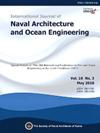Effect of notch shape on the fracture toughness behavior
IF 3.9
3区 工程技术
Q2 ENGINEERING, MARINE
International Journal of Naval Architecture and Ocean Engineering
Pub Date : 2025-01-01
DOI:10.1016/j.ijnaoe.2025.100646
引用次数: 0
Abstract
This study evaluates the effect of notch shape on the fracture toughness of a 500 MPa base material designed for liquefied carbon dioxide storage tanks. This study specifically focuses on assessing the crack tip opening displacement (CTOD) values for different notch shapes, including fatigue pre-cracks (R = 0.025 mm) and electrical discharge machining (EDM) notches (R = 0.07 mm and R = 0.15 mm). CTOD tests were conducted over a temperature range of −55 °C to −140 °C. The results revealed that as the notch radius increased, the degree of stress concentration decreased, leading to an increase in fracture toughness. In temperature-dependent tests, CTOD values consistently decreased as the temperature decreased, with EDM notches exhibiting a lower rate of fracture toughness reduction compared to fatigue pre-cracks, which is attributed to differences in the degree of stress concentration. Scanning electron microscopy analysis of the fracture surfaces revealed the reason for significant differences in CTOD values and fracture behaviors between fatigue pre-crack and EDM notches, particularly at −140 °C, a temperature below the ductile to brittle transition temperature. This study suggests that EDM notches, especially with radii of 0.07 mm and 0.15 mm, can effectively replace fatigue pre-cracks in CTOD evaluations, particularly at temperatures above the transition temperature, offering a more efficient method for assessing fracture toughness in cryogenic environments.
缺口形状对断裂韧性行为的影响
研究了缺口形状对液化二氧化碳储罐用500mpa基材断裂韧性的影响。本研究特别侧重于评估不同缺口形状的裂纹尖端张开位移(CTOD)值,包括疲劳预裂纹(R = 0.025 mm)和电火花加工(EDM)缺口(R = 0.07 mm和R = 0.15 mm)。CTOD测试在- 55°C至- 140°C的温度范围内进行。结果表明,随着缺口半径的增大,应力集中程度减小,导致断裂韧性增加。在温度相关的测试中,CTOD值随着温度的降低而持续下降,与疲劳预裂纹相比,EDM切口的断裂韧性降低率较低,这归因于应力集中程度的差异。对断口表面的扫描电镜分析揭示了疲劳预裂纹和电火花切割缺口之间CTOD值和断裂行为显著差异的原因,特别是在- 140°C,低于韧脆性转变温度。该研究表明,在CTOD评估中,特别是在高于转变温度的温度下,EDM缺口,特别是半径为0.07 mm和0.15 mm的缺口,可以有效地替代疲劳预裂纹,为低温环境下的断裂韧性评估提供了一种更有效的方法。
本文章由计算机程序翻译,如有差异,请以英文原文为准。
求助全文
约1分钟内获得全文
求助全文
来源期刊

International Journal of Naval Architecture and Ocean Engineering
ENGINEERING, MARINE-
CiteScore
4.90
自引率
4.50%
发文量
62
审稿时长
12 months
期刊介绍:
International Journal of Naval Architecture and Ocean Engineering provides a forum for engineers and scientists from a wide range of disciplines to present and discuss various phenomena in the utilization and preservation of ocean environment. Without being limited by the traditional categorization, it is encouraged to present advanced technology development and scientific research, as long as they are aimed for more and better human engagement with ocean environment. Topics include, but not limited to: marine hydrodynamics; structural mechanics; marine propulsion system; design methodology & practice; production technology; system dynamics & control; marine equipment technology; materials science; underwater acoustics; ocean remote sensing; and information technology related to ship and marine systems; ocean energy systems; marine environmental engineering; maritime safety engineering; polar & arctic engineering; coastal & port engineering; subsea engineering; and specialized watercraft engineering.
 求助内容:
求助内容: 应助结果提醒方式:
应助结果提醒方式:


